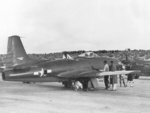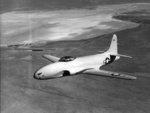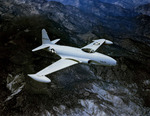P-80 Shooting Star
| Country | United States |
| Manufacturer | Lockheed Corporation |
| Primary Role | Jet Fighter |
| Maiden Flight | 8 January 1944 |
Contributor: C. Peter Chen
ww2dbaseThe American work on the jet fighter, the first of which was the XP-80 project led by Clarence L. "Kelly" Johnson of Lockheed Corporation, began in earnest in mid-1943 after the discovery of the German progress in the same field. US Army Air Forces chief Henry Arnold suggested that the Lockheed airframe could be developed to accept the British Halford H-1 B (shortly after named de Havilland Goblin) turbojet engine, as the British were ahead of the Americans in jet engine research at the time. The first airframe was delivered in Nov 1943, and a Goblin engine was brought to California, United States to be mated with the airframe. Foreign object damage destroyed the first engine, and a second engine was rushed from Britain so that the work could continue. The first prototype, "Lulu-Belle" or "Green Hornet", powered by the second engine, took a successful flight on 8 Jan 1944 with Milo Burcham at the controls. The second prototype variant, designated XP-80A, was designed for the larger American-made General Electric I-40 engine. Two aircraft of this second prototype variant were built, "Gray Ghost" and "Silver Ghost". On 20 Oct 1944, test pilot Burcham was killed flying the third YP-80A prototype. Then, on 20 Mar 1945, "Gray Ghost" was lost in an accident; although test pilot LeVier was able to bail out, he broke his back on the parachute landing, necessitating a six-month recovery time. Four pre-production YP-80A fighters were sent to Europe for operational testing, two to Britain and two to Italy. One of the two sent to Britain crashed at RAF Burtonwood in England, United Kingdom on 28 Jan 1945, killing Major Frederic Borsodi. The two sent to Italy saw front line service as reconnaissance aircraft, flying such missions in Feb and Mar 1945. None of them would see combat before the end of the European War in May 1945. The greatest speed that the prototypes achieved was 808 kilometers per hour (502 miles per hour). Beginning in late Jun 1945, several P-80A aircraft were transferred to the United States Navy; they were further modified with arrestor hooks for operations aboard carrier USS Franklin D. Roosevelt beginning in late 1946. 83 production P-80 aircraft were delivered by the end of Jul 1945. In Aug 1945, Major Richard Bong was killed in a production P-80 aircraft, with a fuel pump failure that took place too close to the ground.
ww2dbaseAfter the war, P-80 jet fighters served in Europe at the start of the Cold War. In 1948, they were redesignated F-80 jet fighters of the United States Air Force. In 1949, US Navy received F-80C aircraft from the US Air Force; US Navy initially designated them TO-1, but this was later changed to TV-1 in 1950. F-80 Shooting Star jet fighters saw extensive combat during the Korean War, with satisfactory results against Soviet-supplied North Korean Yak-9 and Il-10 aircraft. F-80 jet fighters were superseded by North American Aviation's F-86 Sabre jet fighter, which entered production in 1949, and Lockheed's F-94 Starfire jet fighter, which entered production in 1950.
ww2dbaseProduction of this design ended in 1950. By that time a total of 1,714 single-seat P-80/F-80 jet fighters were built. The related two-seat trainer TF-80C/T-33 saw a higher production number of 6,557.
ww2dbaseThe US Air Force made F-80 Shooting Star aircraft obsolete in 1950, and they were later made available to Latin American forces friendly to the United States: Brazil, Chile, Colombia, Ecuador, Peru, and Uruguay. In the 1970s, F-80 fighters in these Latin American forces, as well as those in service with the US Navy, were retired from service. The related T-33 Shooting Star trainer aircraft would remain in service with both the US Air Force and the US Navy until the 1980s.
ww2dbaseSource: Wikipedia
Last Major Revision: Jul 2019
P-80 Shooting Star Timeline
| 18 Jun 1943 | Aircraft designer Clarence Johnson met with Lockheed President Robert Gross and chief engineer Hal Hibbard at the company's headquarters in Burbank, California, United States. Johnson informed the two that US Army Air Force representatives from Wright Field had requested Lockheed to design a jet fighter. |
| 26 Jun 1943 | Aircraft designer Clarence Johnson and his team at Lockheed in Burbank, California, United States began working on the first airframe of the XP-80 prototype jet fighter. |
| 20 Jul 1943 | Lockheed and USAAF began a three day evaluation of a full scale mock up of a XP-80 jet fighter. |
| 22 Jul 1943 | Lockheed and USAAF completed a three day evaluation of a full scale mock up of a XP-80 jet fighter. |
| 16 Nov 1943 | The first XP-80 prototype jet fighter airframe was delivered to Muroc Army Airfield in Lancaster, California, United States. |
| 8 Jan 1944 | The first XP-80A prototype jet aircraft "Lulu-Belle" took its first flight with test pilot Milo Burcham in the cockpit. |
| 1 Aug 1944 | The second XP-80A prototype jet aircraft "Silver Ghost" took its first flight. |
| 13 Sep 1944 | YP-80A jet aircraft took its first flight; the flight lasted about 45 minutes. |
| 20 Oct 1944 | Test pilot Milo Burcham was killed when the YP-80A jet aircraft he piloted crashed shortly after takeoff in Burbank, California, United States. |
| 13 Nov 1944 | Colonel George E. Price received the go-ahead for Project Extraversion, which called for four YP-80A jet aircraft to move to the front lines of the European Theater of Operations for combat testing. |
| 6 Dec 1944 | F-14A jet reconnaissance aircraft took its first flight with Lockheed test pilot Perry E. Claypool, Jr. in the cockpit. |
| 30 Dec 1944 | Two YP-80A jet fighters arrived in Burtonwood, England, United Kingdom. |
| 31 Dec 1944 | Lockheed delivered 13 YP-80A jet aircraft to the USAAF. |
| 28 Jan 1945 | USAAF pilot Major Fredrick Austin Borsodi was killed when the tail of his YP-80A jet fighter disintegrated, causing the aircraft to crash at RAF Burtonwood near Warrington, Cheshire, England, United Kingdom. It was due to the failure of exhaust pipes in the tail section of the aircraft. |
| 20 Mar 1945 | The first XP-80A prototype jet aircraft "Gray Ghost" crashed; test pilot LeVier was able to bail out to safety. |
| 29 Jun 1945 | Several P-80A Shooting Star jet fighters were transferred to the United States Navy. |
| 14 Nov 1945 | A YP-80A jet aircraft crashed during landing during a test flight in Britain. |
| 27 Jan 1946 | Colonel William Councill made the first transcontinental jet flight across the United States (Long Beach, California to New York, New York) in a P-80 jet fighter. The flight time was 4 hours, 13 minutes, and 26 seconds, and the average speed of 940 kilometers per hour (584 miles per hour). |
| 31 Oct 1946 | P-80A jet fighters began service aboard carrier USS Franklin D. Roosevelt. |
| 1 Nov 1946 | P-80A jet fighters made the first takeoff and landing operations, with US Marine Corps pilots, aboard carrier USS Franklin D. Roosevelt. |
| 19 Jun 1947 | A P-80R jet aircraft, piloted by Colonel Albert Boyd, set a world air speed record of 1,004.2 kilometers per hour (623.73 miles per hour). |
| 11 Jun 1948 | P-80C jet fighters were redesignated F-80C fighters in the United States Air Force. |
| 28 Jun 1950 | RF-80A jet aircraft conducted its first combat reconnaissance mission over Korea with 1st Lieutenant Bryce Poe II in the cockpit. |
| 8 Nov 1950 | Lieutenant Russell J. Brown, flying a F-80 jet fighter, claimed the first American jet-versus-jet victory over Korea after shooting down a MiG-15 fighter. |
SPECIFICATIONS
F-80C
| Machinery | One Allison J33-A-35 centrifugal compressor turbojet engine rated at 4600 lbf (20.46 kN) / 5400 lbf (24.02 kN) with water injection |
| Armament | 6x12.7mm AN/M3 Browning machine guns, 8x127mm unguided rockets, 2x454kg bombs |
| Crew | 1 |
| Span | 11.81 m |
| Length | 10.49 m |
| Height | 3.43 m |
| Wing Area | 22.07 m² |
| Weight, Empty | 3,819 kg |
| Weight, Loaded | 5,738 kg |
| Weight, Maximum | 7,646 kg |
| Speed, Maximum | 965 km/h |
| Speed, Cruising | 660 km/h |
| Rate of Climb | 23.30 m/s |
| Service Ceiling | 14,000 m |
| Range, Normal | 1,930 km |
Photographs
 |  |  |  |
Please consider supporting us on Patreon. Even $1 per month will go a long way! Thank you. Please help us spread the word: Stay updated with WW2DB: |
- » US Government Plans to Purge WW2 Information (17 Mar 2025)
- » WW2DB's 20th Anniversary (29 Dec 2024)
- » Wreck of USS Edsall Found (14 Nov 2024)
- » See all news
- » 1,162 biographies
- » 337 events
- » 44,601 timeline entries
- » 1,243 ships
- » 350 aircraft models
- » 207 vehicle models
- » 376 weapon models
- » 123 historical documents
- » 261 facilities
- » 470 book reviews
- » 28,631 photos
- » 429 maps
Joachim von Ribbentrop, German Foreign Minister, Aug 1939
Please consider supporting us on Patreon. Even $1 a month will go a long way. Thank you!
Or, please support us by purchasing some WW2DB merchandise at TeeSpring, Thank you!